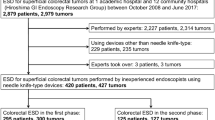Abstract
Purpose: Approximately 50 percent of all patients with resected colorectal carcinoma have tumors with pT3 status; however, no subclassifications of the penetration depth have been proposed. The purpose of this study is to evaluate the significance of histologic invasion beyond subserosal elastic lamina by colorectal carcinoma for postoperative recurrence and long-term survival after resection. Methods: pT3 colorectal carcinomas located above the peritoneal reflection were retrospectively classified into two depth grades (subserosal elastic laminaclassification). Namely, “pT3-shallow” is defined as tumors those are confined above the subserosal elastic lamina, and “pT3-deep” is defined as tumors those penetrate beyond it. Based on subserosal elastic lamina classification, the 325 consecutive patients who underwent resections were divided into two groups, and then the clinicopathologic features, incidence of postoperative recurrence, and survival rates were compared between the two groups. Results: The overall post-operative recurrence rate in the pT3-deep group (35.2 percent) was higher than that in the pT3-shallow group (20.8 percent). In detail, liver and peritoneal recurrence rates in the pT3-deep group (19.7 percent, 7.7 percent, respectively) were higher than those in the pT3-shallow group (9.4 percent, 2.0 percent, respectively). There was a strong difference (P < 0.0001) in overall survival rate between the pT3-deep group (5-year survival of 57.0 percent) and the pT3-shallow group (5-year survival of 78.6 percent). Multivariate analysis revealed that synchronous hematogenous metastasis (P < 0.0001), lymph node metastasis (P < 0.05), venous invasion (P < 0.01), and subserosal elastic lamina classification (P < 0.05) were the independent prognostic factors for postoperative survival. Conclusions: The newly proposed subserosal elastic lamina classification is a useful subclassification to predict the prognosis of patients with resected pT3 colorectal carcinomas.
Similar content being viewed by others
References
Sobin LH, Wittekind CH. UICC TNM classification of malignant tumours. 5th ed., New York, Wiley-Liss, 1997
Japanese Society for Cancer of the Colon and Rectum. Multi-institutional registry of large bowel cancer in Japan. Vol 20. Cases treated in 1992. Tokyo: Japanese Society for Cancer of the Colon and Rectum; 2000.
Japanese Society for Cancer of the Colon and Rectum. Multi-institutional registry of large bowel cancer in Japan. Vol 19. Cases treated in 1991. Tokyo: Japanese Society for Cancer of the Colon and Rectum; 2000.
Shepherd NA, Baxter KJ, Love SB. The prognostic importance of peritoneal involvement in colonic cancer: a prospective evaluation. Gastroenterology 1997; 112: 1096–102
Hida J, Yasutomi M, Maruyama T, Fujimoto K, Uchida T, Okuno K. The extent of lymph node dissection for colon carcinoma: the potential impact on laparoscopic surgery. Cancer 1997; 80: 188–92
Quirke P, Durdey P, Dixon MF, Williams NS. Local recurrence of rectal adenocarcinoma due to inadequate surgical resection. Histopathological study of lateral tumour spread and surgical excision. Lancet 1986; 2: 996–8
Cawthorn SJ, Parums DV, Gibbs NM, et al. Extent of mesorectal spread and involvement of lateral resection margin as prognostic factors after surgery for rectal cancer. Lancet 1990; 335: 1055–9
Bunker ML, Raab SS, Landreneau RJ, Silverman JF. The diagnosis and significance of visceral pleural invasion in lung carcinoma. Histologic predictors and the role of elastic stains. Am J Clin Pathol 1999; 112: 777–83
Gallagher B, Urbanski SJ. The significance of pleural elastica invasion by lung carcinomas. Hum Pathol 1990; 21: 512–7
Hammar, SP (1994) “Common neoplasms”, In: Dail, DH, Hammar, SP Pulmonary pathology, 2nd ed., Springer-Verlag, New York, pp 1138
The Japan Lung Cancer Society (1999) General rule for clinical and pathological record of lung cancer, 5th ed., Kanehara, Tokyo
Fenoglio-Preiser, CM (1999) “Gastrointestinal pathology: an atlas and text”, 2nd ed., Lippincott-Raven, Philadelphia, pp 760
Kaplan E, Meier P. Nonparametric estimation from incomplete observations. J Am Stat Assoc 1958; 53: 457–81
Mantel N. Evaluation of surgical data and two new rank order statistics arising in its consideration. Cancer 1966; 50: 163–70
Cox DR. Regression models and life-tables. J Rl Stat Soc Ser B 1972; 34: 187–20
Dukes CE. The classification of cancer of the rectum. J Pathol 1932; 35: 323–32
Astler VB, Coller FA. The prognostic significance of direct extension of carcinoma of the colon and rectum. Ann Surg 1954; 139: 846–52
Takahashi Y, Tucker SL, Kitadai Y, et al. Vessel counts and expression of vascular endothelial growth factor as prognostic factors in node-negative colon cancer. Arch Surg 1997; 132: 541–6
Erenoglu C, Akin ML, Uluutku H, Tezcan L, Yildirim S, Batkin A. Angiogenesis predicts poor prognosis in gastric carcinoma. Dig Surg 2000; 17: 581–6
Choi HJ, Hyun MS, Jung GJ, Kim SS, Hong SH. Tumor angiogenesis as a prognostic predictor in colorectal carcinoma with special reference to mode of metastasis and recurrence. Oncology 1998; 55: 575–81
Tomisaki S, Ohno S, Ichiyoshi Y, Kuwano H, Maehara Y, Sugimachi K. Microvessel quantification and its possible relation with liver metastasis in colorectal cancer. Cancer 1996; 77: 1722–78
Author information
Authors and Affiliations
Corresponding author
About this article
Cite this article
Shinto, E., Ueno, H., Hashiguchi, Y. et al. The subserosal elastic lamina: An anatomic landmark for stratifying pT3 colorectal cancer. Dis Colon Rectum 47, 467–473 (2004). https://doi.org/10.1007/s10350-003-0083-9
Issue Date:
DOI: https://doi.org/10.1007/s10350-003-0083-9




